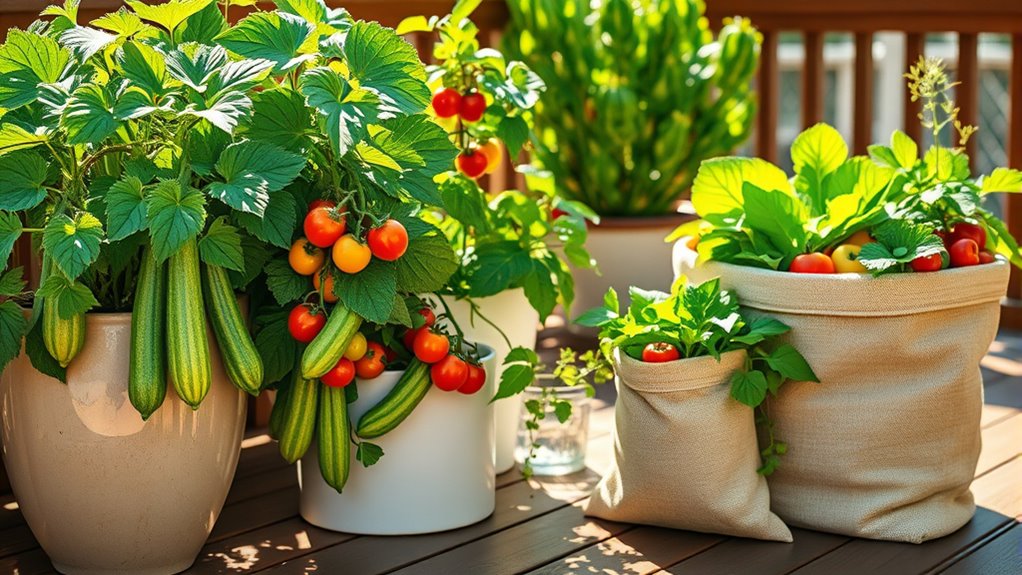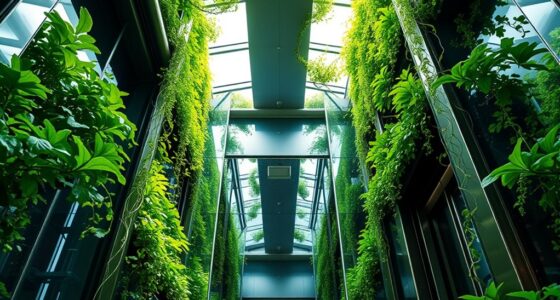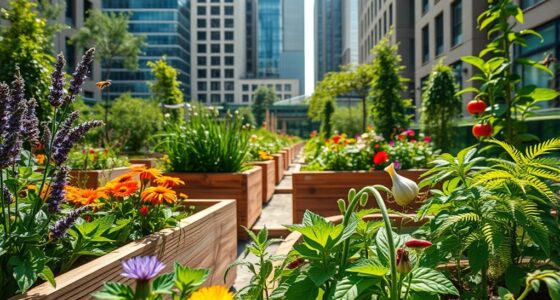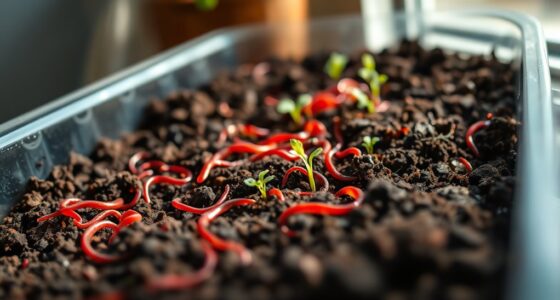For a thriving patio container garden, choose vegetables like cherry tomatoes, peppers, bush beans, and compact cucumbers that grow well in small spaces. Use containers with good drainage and high-quality potting mix, and support climbing plants with trellises. Consider leafy greens and herbs such as lettuce, spinach, basil, and parsley for continuous harvests. With proper sunlight, watering, and support, you’ll enjoy fresh produce; discover more tips to maximize your outdoor space.
Key Takeaways
- Choose compact, space-efficient vegetables like cherry tomatoes, bush beans, and dwarf peppers suitable for small containers.
- Use containers with proper drainage and high-quality potting soil for healthy root development.
- Grow vining crops such as cucumbers and peas vertically with trellises to maximize limited patio space.
- Select sun-loving vegetables that require at least 6 hours of direct sunlight daily for optimal growth.
- Incorporate herbs like basil, parsley, and cilantro for continuous harvests and easy container gardening.
Choosing the Right Containers and Soil for Your Patio Garden
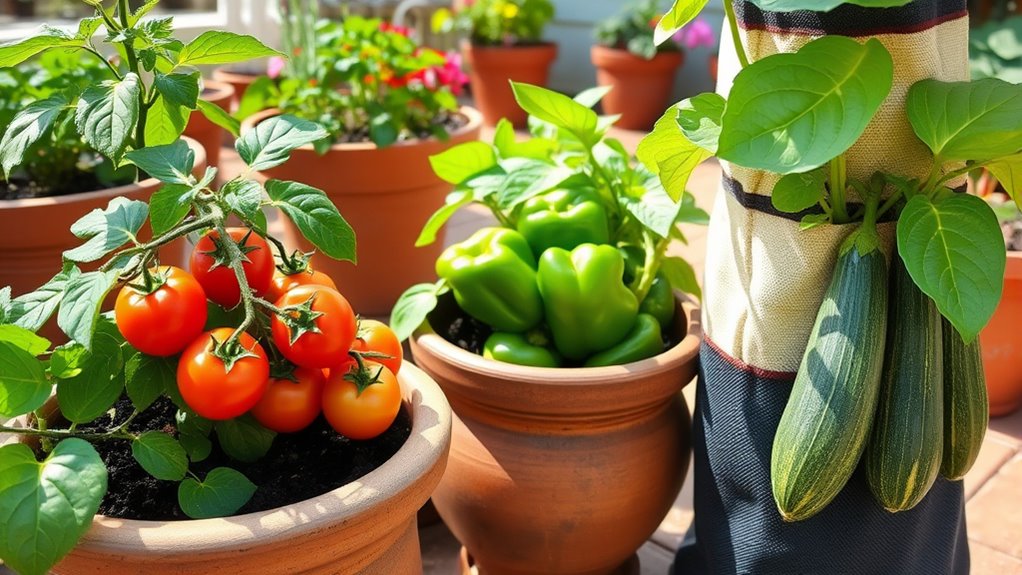
To guarantee your patio garden thrives, choosing the right containers and soil is essential. Select a container with drainage holes suited to each vegetable’s root system—10-gallon pots work well for tomatoes, while 5-gallon containers suit peppers.
Use high-quality potting soil mixes formulated for containers, combining peat moss, compost, and perlite to ensure proper drainage and nutrient retention. Incorporate organic amendments or slow-release fertilizers into the soil to provide steady nutrients throughout the season.
Choose premium container soil with peat moss, compost, and perlite for optimal drainage and nutrients.
Opt for durable containers made from glazed ceramic, plastic, or metal, which withstand outdoor conditions and help regulate soil temperature.
Place your containers on stable, water-permeable surfaces or plant stands to promote proper drainage and prevent waterlogging.
Additionally, understanding the importance of soil composition helps in selecting the right amendments to promote healthy plant growth.
Proper container size and soil choice set the foundation for healthy, productive vegetables.
Top Vegetables for Compact and Container-Friendly Growth
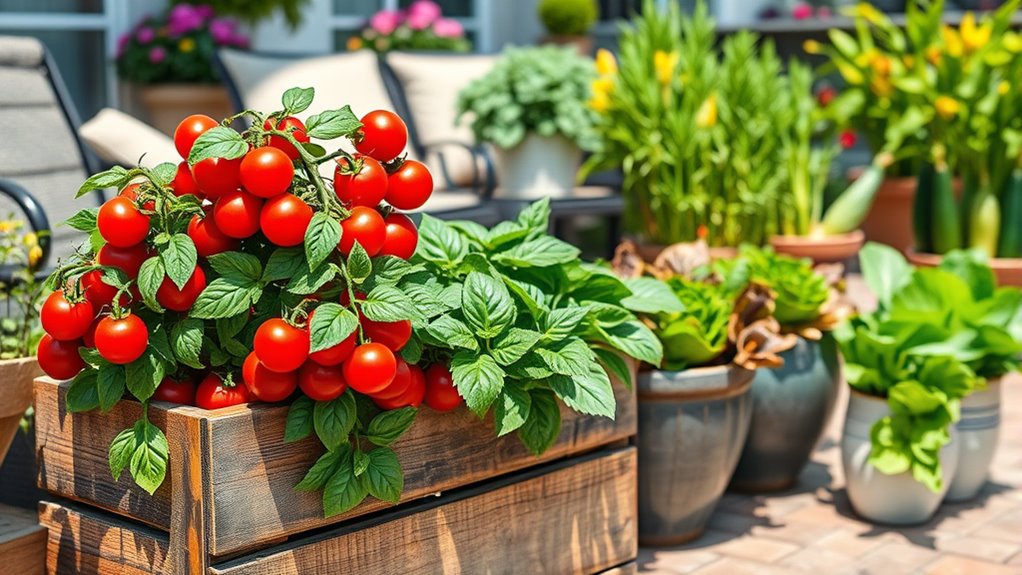
Some vegetables are perfect for small spaces and container gardening, thanks to their compact growth habits. You’ll find varieties like cherry tomatoes, bush beans, and dwarf peppers that thrive in limited areas. Using good lighting ensures healthy growth and abundant yields. Supporting climbing vegetables like peas and cucumbers with trellises maximizes vertical space and productivity. Additionally, selecting ergonomic furniture or adjustable containers can make tending your garden more comfortable and efficient. To ensure your plants thrive, understanding size restrictions for tiny houses can help you optimize your gardening setup within limited spaces. Incorporating wealth protection strategies can also help safeguard your gardening investments and resources. Proper aesthetic design can also enhance the visual appeal of your patio garden while maintaining functionality.
Space-Saving Varieties
If you’re short on space but still want a thriving vegetable garden, choosing compact varieties is your best bet. Space-saving vegetables like bush beans, dwarf eggplants, and patio peppers thrive in small containers, making the most of limited space.
Vertical growing options, such as mini zucchini and cucumbers like Bush Champion, help you maximize vertical space with support structures.
Short-rooted carrots, like Paris Market and Bulls Blood, do well in shallow containers, saving ground space.
Combining these varieties in multi-purpose or combo containers allows you to grow a variety of vegetables without overcrowding your patio.
These compact varieties are designed to flourish in small containers, giving you fresh produce while maintaining a tidy, manageable garden setup. Additionally, choosing disease-resistant plants can help ensure a healthy harvest with fewer issues.
Support Needs
Many vegetables suited for container gardening, such as peas, cucumbers, and pole beans, benefit from vertical support structures like trellises, cages, or stakes. These support structures help maximize space, keep plants upright, and prevent breakage. Incorporating aesthetic wall organization elements, such as decorative supports or stylish cages, can also enhance the visual appeal of your patio garden. For vining crops, lightweight, portable supports are ideal, as they can be adjusted or removed as plants grow or seasons change. Compact varieties, like bush tomatoes, dwarf eggplants, and patio peppers, are bred to thrive without extensive support, making them perfect for smaller containers. Proper plant support improves air circulation, reducing disease risks and promoting plant health. Selecting the appropriate support type based on plant needs and container size helps optimize yield, keeps your patio organized, and ensures your container garden remains attractive and productive. Additionally, choosing self watering plant pots can help maintain consistent moisture levels, reducing the need for frequent watering and supporting healthy growth. Incorporating support systems that are easy to install and adjust can also make maintenance easier and reduce plant stress during inclement weather.
Tips for Growing Tomatoes and Peppers in Limited Spaces
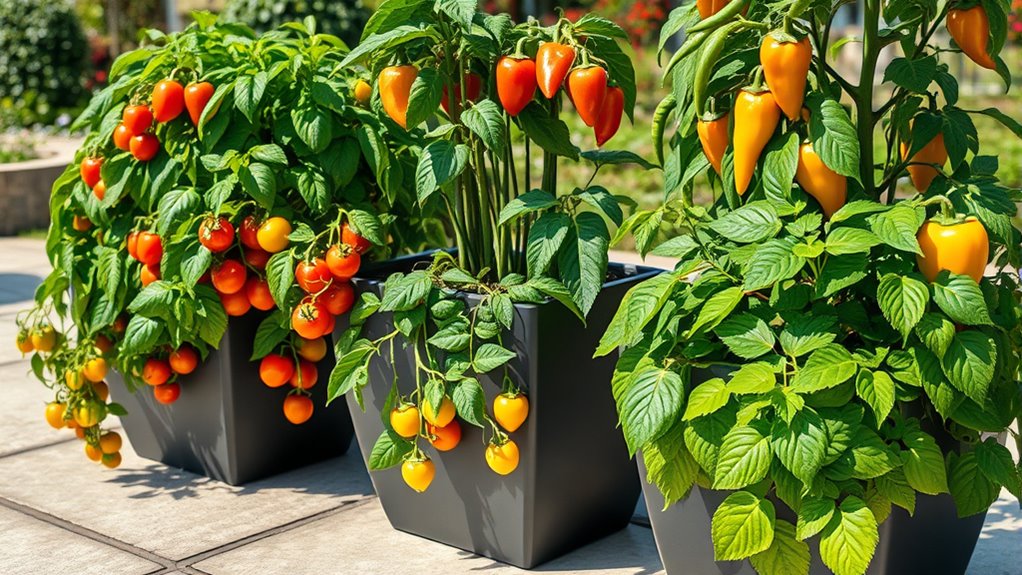
To make the most of limited space, choose compact or determinate tomato and pepper varieties that stay manageable. Use large containers with good drainage and support your plants with stakes or cages to prevent breakage. Guarantee they get at least 6-8 hours of full sun daily to encourage healthy growth and fruiting. Additionally, consider proper installation and venting factors when selecting your containers and plants to stay within your gardening budget.
Selecting Compact Varieties
Choosing the right compact varieties is key when growing tomatoes and peppers in limited spaces. Look for compact varieties like determinant tomatoes, such as Bush Early Girl or Grow BushSteak, which stay under 3 feet tall and are easier to manage in small containers. For peppers, dwarf or bush-type options like California Wonder or Sweet Banana reach only 12 to 18 inches, making them perfect for patio gardening. Use appropriately sized containers—at least 5 gallons for tomatoes and 3 gallons for peppers—to guarantee healthy root development. Place your plants in full sun, ideally receiving 6-8 hours daily, to maximize growth. Ensuring optimal suction power and filtration helps maintain healthy plant environments and reduces pests and diseases. Selecting these compact varieties and container sizes helps you make the most of limited space while enjoying fresh vegetables on your patio. Additionally, choosing containers with adequate drainage is essential to prevent waterlogging and root rot.
Optimizing Container Support
Using sturdy support structures like trellises, cages, or stakes is essential for keeping your container-grown tomatoes and peppers upright and stable. Support structures provide the necessary container support to manage vertical growth and prevent tipping. Choose trellises, stakes, or cages specifically designed for containers to ensure stability. Install these supports early in planting to avoid damaging roots later and give plants time to establish. Secure supports firmly into the container with anchors or weights to withstand wind and the weight of mature fruit. Regularly tie or prune your plants to supports to maintain airflow, reduce breakage, and promote healthy, productive growth in limited space. Additionally, understanding how arcade games work can help you appreciate the mechanics behind game design and maintenance, ensuring your gaming setup remains engaging and functional. Proper support structures are key to maximizing container gardening success on your patio. Creating a support system tailored to your plant’s needs can also enhance overall plant health and yield.
Ensuring Sufficient Sunlight
Growing tomatoes and peppers successfully in limited spaces depends heavily on ensuring they receive enough sunlight. Most need at least six hours of direct sun daily, so position your containers on sunny patios or near south-facing walls for optimal exposure.
To boost sunlight, place reflective surfaces like white walls or light-colored patio floors around your plants, which bounce extra light onto them. Opt for compact or bush varieties, as they tend to perform better in limited sunlight. Additionally, choosing appropriate plant varieties can significantly improve your success rate in confined spaces. Being aware of plant growth habits helps in selecting the best types that thrive in containers.
Furthermore, using support structures can help maximize space and improve air circulation around your plants, promoting healthier growth. Incorporating proper watering techniques ensures your plants receive adequate moisture without overwatering. Periodically rotate your containers to ensure all sides of the plants get adequate sun, promoting even growth and better yields. By maximizing sunlight and adjusting your setup, you’ll improve plant growth and enjoy healthy, productive vegetables even in smaller spaces.
Growing Leafy Greens and Herbs for Continuous Harvests
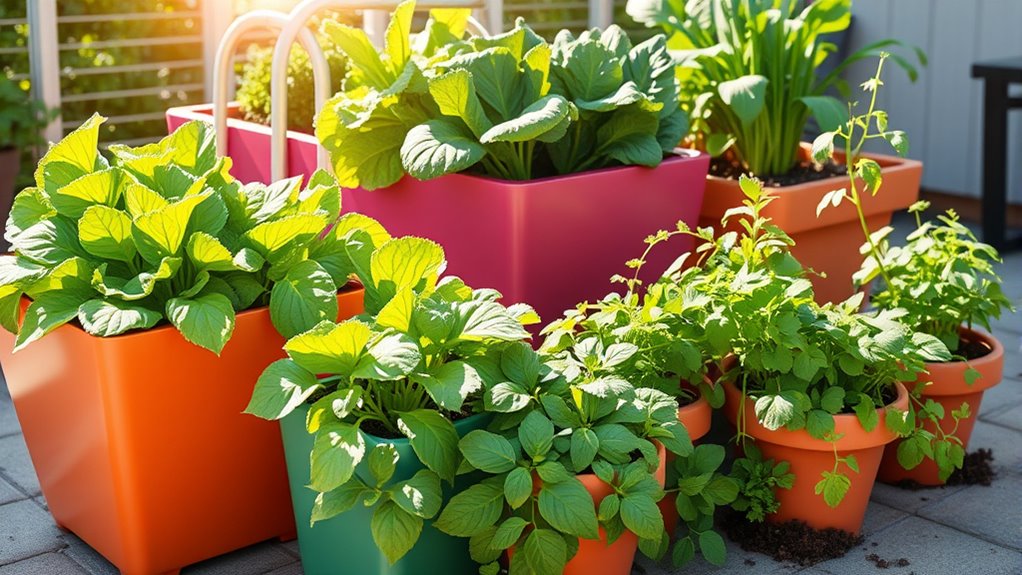
To guarantee a continuous harvest of leafy greens and herbs, you should plant in shallow containers of 2-4 inches deep, which promote quick growth and easy access. Leafy greens like lettuce, arugula, and spinach thrive in these small pots, allowing you to harvest repeatedly.
Plant leafy greens and herbs in shallow 2-4 inch containers for quick, continuous harvests.
Herbs such as basil, parsley, cilantro, and chives grow vigorously in container gardening, providing fresh flavor and multiple harvests over weeks. Practice succession planting every 2-3 weeks to keep your supply steady and maximize space.
Use a high-quality potting mix enriched with organic compost to support healthy growth. Remember to provide partial shade during hot days to prevent bolting and maintain tender leaves.
For optimal results, consider using specialized containers designed for vegetable growth to improve drainage and root development. Properly managed, your patio will be a continuous source of fresh greens and herbs.
Managing Support and Watering Needs in Small-Scale Gardens
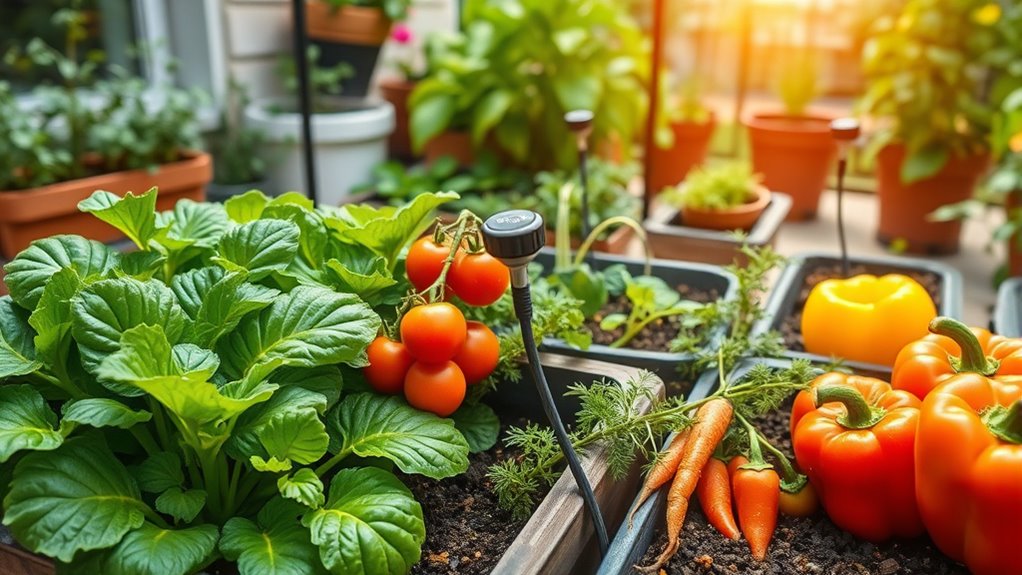
Maximizing space and ensuring plant stability requires installing appropriate support structures such as trellises, cages, or stakes, especially for vining vegetables like cucumbers, beans, and peas. These support structures help utilize vertical space efficiently and keep plants upright, preventing toppling in container gardening.
Secure supports firmly in the container to maintain plant stability, even in windy conditions. Regular pruning or training along supports improves air circulation, reduces disease risk, and makes watering more efficient.
Keep soil moisture consistent by watering at the base early in the day to prevent runoff and ensure deep penetration. Managing support and watering needs carefully promotes healthy growth, maximizes yield, and keeps your small-scale garden thriving.
Extending the Growing Season With Container Gardening Techniques
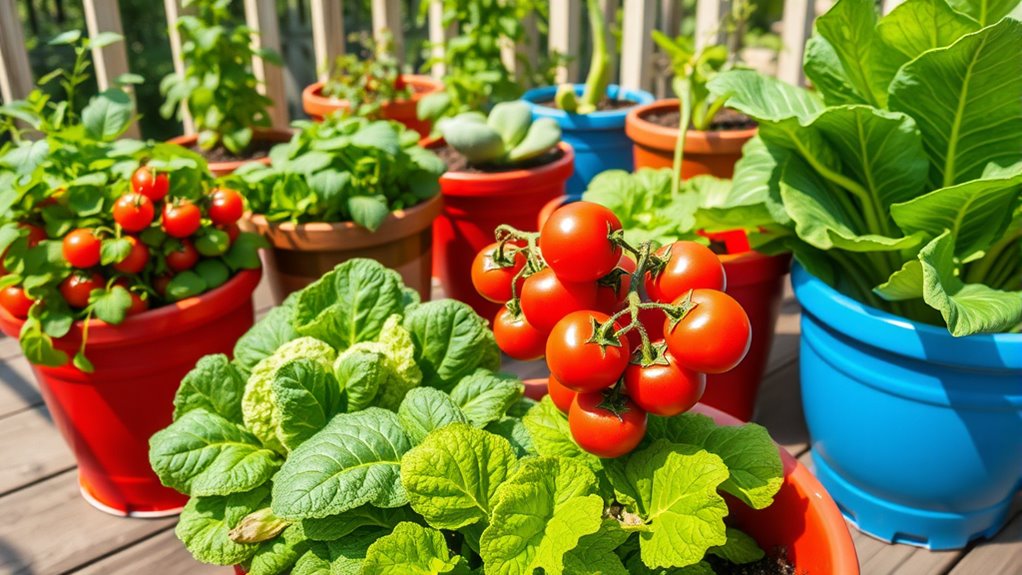
Extending your growing season with container gardening techniques allows you to harvest fresh vegetables for longer periods. By using strategies like early planting and proper container placement, you can maximize your garden’s productivity. Containers warm the soil faster than traditional beds, enabling you to grow in containers earlier in spring. Insulating the soil with mulch or thermal covers helps retain heat during cooler months, prolonging harvests. Choosing heat-tolerant varieties and adjusting planting schedules to seasonal temperatures also boosts your yields. Additionally, supplemental lighting extends daylight hours, especially indoors or shaded patios. Properly positioning containers in sunny spots and shielding from early frosts ensures ideal conditions. Here’s a quick visual:
| Technique | Benefit | Application |
|---|---|---|
| Warm soil with containers | Extend growing season | Early planting in spring |
| Insulate with mulch | Prolong harvest | Cooler months |
| Strategic container placement | Maximize sun and protect from frost | Longer fall growth |
| Use heat-tolerant varieties | Increase heat resilience | Match seasonal temperatures |
| Add grow lights | Extend daylight hours | Indoor or shaded patios |
Frequently Asked Questions
What Vegetables Can I Grow on a Patio?
You can grow a variety of vegetables on your patio. Cherry tomatoes, peppers, and herbs thrive in containers, providing high yields in small spaces.
Leafy greens like lettuce and spinach grow quickly with minimal room.
Root vegetables such as carrots and radishes do well in deep pots.
Vining vegetables like cucumbers can climb on supports.
Heat-loving plants like eggplant and okra flourish in sunny spots.
What Are the Easiest Vegetables to Grow in Pots?
You want to know the easiest vegetables to grow in pots. Leafy greens like lettuce, spinach, and arugula are fantastic because they grow fast and have shallow roots.
Radishes and spring onions are simple and quick to harvest.
Cherry tomatoes such as ‘Patio’ or ‘Tiny Tim’ are forgiving for beginners.
Herbs like basil, parsley, and cilantro are low-maintenance and can be harvested often.
Peas, especially dwarf varieties, are also easy and thrive in containers.
What Is the Easiest Plant to Grow on a Patio?
Thinking you need a green thumb? Don’t worry—growing on a patio is easier than you think. The simplest plant to start with is herbs like basil, mint, or chives. They thrive in small containers, require minimal care, and give you fresh flavors anytime.
With just a little water and some sunlight, you’ll enjoy lush herbs, boosting your confidence and making your patio a vibrant, useful space.
What Are the Best Vegetables for a Porch?
When choosing the best vegetables for your porch, go for compact, easy-to-manage varieties. You should try cherry or patio tomatoes, which thrive in small pots, and herbs like basil, parsley, and chives that need shallow containers.
Leafy greens such as lettuce and spinach grow quickly and suit limited space. Dwarf peppers and root vegetables like radishes also do well, provided you use appropriately sized containers and guarantee they get enough sunlight.
Conclusion
Container gardening lets you enjoy fresh vegetables right on your patio, even in small spaces. Did you know that in 2022, over 70% of urban gardeners reported increased satisfaction from growing their own produce? With the right containers, soil, and care, you can harvest tasty, healthy vegetables all season long. So go ahead, start your patio garden today—you might be surprised at how much you can grow in just a few pots!
